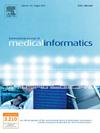“我不知道”:一个不确定性感知机器学习模型,用于预测急诊科分诊时患者的处置情况
IF 3.7
2区 医学
Q2 COMPUTER SCIENCE, INFORMATION SYSTEMS
International Journal of Medical Informatics
Pub Date : 2025-04-28
DOI:10.1016/j.ijmedinf.2025.105957
引用次数: 0
摘要
机器学习(ML)模型被广泛用于预测急诊科(ED)分诊时的患者处置。然而,这些模型产生的预测不考虑不确定性的水平,可能导致过度自信的输出,从而损害临床决策。目的建立一种适合急诊科分诊的适形预测模型,为不确定性患者倾向预测提供依据。方法回顾性研究分析了2014年3月至2017年7月间来自一家学术医院和两家社区医院的560,486例成人急诊科就诊情况。对极端梯度增强(XGBoost)模型进行了训练、验证和整合,以引入对高不确定性情况的“不知道”预测。该模型在56000例ED病例的随机样本上进行了测试。结果标准XGBoost模型的AUC为0.9307 (95% CI: 0.9285 ~ 0.9329),灵敏度为0.72,特异性为0.94。在较低置信阈值为60%的适形预测下,该模型在4.9%的病例中显示“不知道”,灵敏度和特异性分别为0.74和0.95。随着置信阈值的增加,模型返回的“不知道”预测更多,错误分类更少。在90%的置信度下,该模型在34.5%的病例中返回“不知道”,同时返回的灵敏度和特异性值分别为0.88和0.99。这种权衡突出了模型置信度和预测准确性之间的平衡。结论在ML模型中加入不确定性意识提高了急诊科分诊的可靠性。通过承认不确定性,临床医生可以获得更多可解释的见解,减少过度自信预测的风险,提高患者安全。本文章由计算机程序翻译,如有差异,请以英文原文为准。
“I don’t know”: An uncertainty-aware machine learning model for predicting patient disposition at emergency department triage
Background
Machine learning (ML) models are widely used for predicting patient disposition at emergency department (ED) triage. However, these models generate predictions regardless of the level of uncertainty, potentially leading to overconfident outputs that can compromise clinical decision-making.
Objective
To develop a conformal prediction model for ED triage that provides uncertainty-aware patient disposition predictions.
Methods
This retrospective study analyzed 560,486 adult ED visits (March 2014 – July 2017) from one academic and two community hospitals. An extreme gradient boosting (XGBoost) model was trained, validated, and conformalized to introduce a “Don’t know” prediction for high-uncertainty cases. The model was tested on a random sample of 56,000 ED cases.
Results
The standard XGBoost model achieved an AUC of 0.9307 (95% CI: 0.9285 – 0.9329), with sensitivity of 0.72 and specificity of 0.94. With conformal prediction at a lower confidence threshold of 60%, the model indicated “Don’t know” in 4.9% of cases while returning sensitivity and specificity values of 0.74 and 0.95, respectively. As confidence thresholds increased, the model returned more “Don’t know” predictions and fewer misclassifications. At 90% confidence, the model returned “Don’t know” in 34.5% of cases while returning sensitivity and specificity values of 0.88 and 0.99, respectively. This trade-off highlights a balance between model confidence and prediction accuracy.
Conclusion
Incorporating uncertainty-awareness in ML models improves reliability in ED triage. By acknowledging uncertainty, clinicians receive more interpretable insights, reducing the risk of overconfident predictions and enhancing patient safety.
求助全文
通过发布文献求助,成功后即可免费获取论文全文。
去求助
来源期刊

International Journal of Medical Informatics
医学-计算机:信息系统
CiteScore
8.90
自引率
4.10%
发文量
217
审稿时长
42 days
期刊介绍:
International Journal of Medical Informatics provides an international medium for dissemination of original results and interpretative reviews concerning the field of medical informatics. The Journal emphasizes the evaluation of systems in healthcare settings.
The scope of journal covers:
Information systems, including national or international registration systems, hospital information systems, departmental and/or physician''s office systems, document handling systems, electronic medical record systems, standardization, systems integration etc.;
Computer-aided medical decision support systems using heuristic, algorithmic and/or statistical methods as exemplified in decision theory, protocol development, artificial intelligence, etc.
Educational computer based programs pertaining to medical informatics or medicine in general;
Organizational, economic, social, clinical impact, ethical and cost-benefit aspects of IT applications in health care.
 求助内容:
求助内容: 应助结果提醒方式:
应助结果提醒方式:


